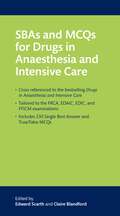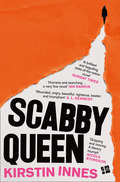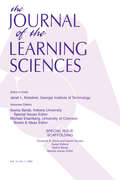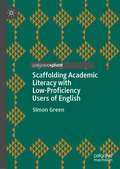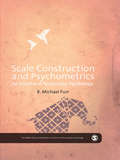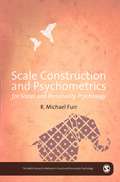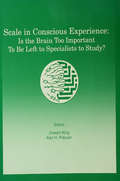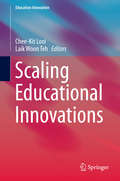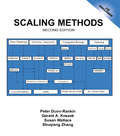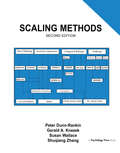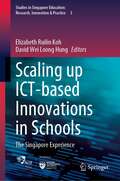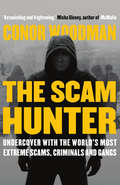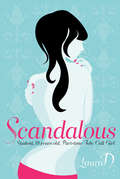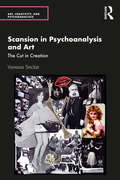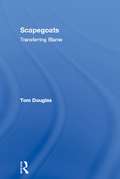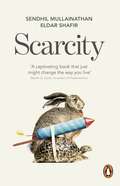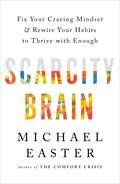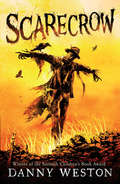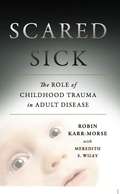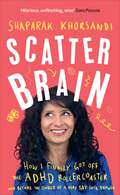- Table View
- List View
SBAs and MCQs for Drugs in Anaesthesia and Intensive Care
by Dr Claire Blandford Edward ScarthDesigned to complement the highly popular Drugs in Anaesthesia and Intensive Care, this companion title provides high quality pharmacology practice questions for exam revision. Focusing specifically on pharmacological principles and agents, it is tailored for postgraduate exams in anaesthesia and intensive care including the FRCA, FFICM, the EDAIC, and the EDIC. Over 230 True/False MCQs and Single Best Answers help readers to test and consolidate knowledge learnt from Drugs in. Questions are arranged into 17 subject-themed chapters such as 'Intravenous anaesthetic agents' to focus revision. Structured questions and answers are accompanied by detailed explanations, cross-references to Drugs in where relevant, and further reading. Written by consultants and experienced trainees, SBAs and MCQs for Drugs in Anaesthesia and Intensive Care offers a true test of the reader's pharmacology knowledge, and is an essential purchase for anyone preparing for their anaesthetic and intensive care examinations, including the Fellowship of the Royal College of Anaesthetists (FRCA), the European Diploma in Anaesthesiology and Intensive Care (EDAIC), the Fellowship of the Faculty of Intensive Care Medicine (FFICM), and the European Diploma in Intensive Care Medicine (EDIC) examinations.
SBAs and MCQs for Drugs in Anaesthesia and Intensive Care
Designed to complement the highly popular Drugs in Anaesthesia and Intensive Care, this companion title provides high quality pharmacology practice questions for exam revision. Focusing specifically on pharmacological principles and agents, it is tailored for postgraduate exams in anaesthesia and intensive care including the FRCA, FFICM, the EDAIC, and the EDIC. Over 230 True/False MCQs and Single Best Answers help readers to test and consolidate knowledge learnt from Drugs in. Questions are arranged into 17 subject-themed chapters such as 'Intravenous anaesthetic agents' to focus revision. Structured questions and answers are accompanied by detailed explanations, cross-references to Drugs in where relevant, and further reading. Written by consultants and experienced trainees, SBAs and MCQs for Drugs in Anaesthesia and Intensive Care offers a true test of the reader's pharmacology knowledge, and is an essential purchase for anyone preparing for their anaesthetic and intensive care examinations, including the Fellowship of the Royal College of Anaesthetists (FRCA), the European Diploma in Anaesthesiology and Intensive Care (EDAIC), the Fellowship of the Faculty of Intensive Care Medicine (FFICM), and the European Diploma in Intensive Care Medicine (EDIC) examinations.
Scabby Queen
by Kirstin Innes‘Gripping and moving. A literary triumph’ Nicola Sturgeon ‘A humane and searching story’ Ian Rankin ‘Kirstin Innes is aiming high, writing for readers in the early days of a better nation’ A.L. Kennedy
Scaffolding: A Special Issue of the Journal of the Learning Sciences
by Elizabeth A. Davis Naomi Miyake GuestThis special issue works toward refining the understanding of a construct that has had a name for nearly 30 years and has been used by educators of all stripes for centuries. The introduction lays the groundwork for discussing the issues addressed throughout. Each of the papers address different aspects of a similar problem: How can we conceptualize, design, and assess the effects of scaffolding when it is implemented in a complex classroom system? The first article addresses a core problem in conceptualizing scaffolding: What are the specific goals of scaffolding provided in software tools? The next paper extends this consideration of how scaffolding mechanisms can complement each other and explores issues having to do with the complex settings in which scaffolding is used. A framework which synthesizes theoretical and design work done in cognitive science, psychology, educational technology, science education, and the learning sciences over the last three decades is the topic of the third paper. The final article presents a new method for analyzing the effects of scaffolding. This special issues closes with commentary covering different components of a definition of scaffolding, including the "what, why, and how" of scaffolding.
Scaffolding: A Special Issue of the Journal of the Learning Sciences
by Elizabeth A. Davis Naomi MiyakeThis special issue works toward refining the understanding of a construct that has had a name for nearly 30 years and has been used by educators of all stripes for centuries. The introduction lays the groundwork for discussing the issues addressed throughout. Each of the papers address different aspects of a similar problem: How can we conceptualize, design, and assess the effects of scaffolding when it is implemented in a complex classroom system? The first article addresses a core problem in conceptualizing scaffolding: What are the specific goals of scaffolding provided in software tools? The next paper extends this consideration of how scaffolding mechanisms can complement each other and explores issues having to do with the complex settings in which scaffolding is used. A framework which synthesizes theoretical and design work done in cognitive science, psychology, educational technology, science education, and the learning sciences over the last three decades is the topic of the third paper. The final article presents a new method for analyzing the effects of scaffolding. This special issues closes with commentary covering different components of a definition of scaffolding, including the "what, why, and how" of scaffolding.
Scaffolding Academic Literacy with Low-Proficiency Users of English
by Simon GreenThis book analyses the development of academic literacy in low-proficiency users of English in the Middle East. It highlights the challenges faced by students entering undergraduate education in the region, and the strategies used by teachers to overcome them. The author focuses on a large-scale undergraduate teacher programme run in Oman by the University of Leeds, providing clear pointers both for future research and effective practice. He also explores the implications of his findings for countries beyond the Gulf Cooperation Council, demonstrating how international participation in UK HE could be much wider. This book will appeal to students and scholars with an interest in academic literacies and English for Academic Purposes.
Scale Construction and Psychometrics for Social and Personality Psychology
by Mike FurrElectronic Inspection Copy available for instructors here Providing conceptual and practical foundations in scale construction and psychometrics for producers and consumers of social/personality research, this guide covers basic principles, practices, and processes in scale construction, scale evaluation, scale use, and interpretation of research results in the context of psychological measurement. It explains fundamental concepts and methods related to dimensionality, reliability, and validity. In addition, it provides relatively non-technical introductions to special topics and advanced psychometric perspectives such as Confirmatory Factor Analysis, Generalizability Theory, and Item Response Theory. The SAGE Library in Social and Personality Psychology Methods provides students and researchers with an understanding of the methods and techniques essential to conducting cutting-edge research. Each volume within the Library explains a specific topic and has been written by an active scholar (or scholars) with expertise in that particular methodological domain. Assuming no prior knowledge of the topic, the volumes are clear and accessible for all readers. In each volume, a topic is introduced, applications are discussed, and readers are led step by step through worked examples. In addition, advice about how to interpret and prepare results for publication are presented.
Scale Construction and Psychometrics for Social and Personality Psychology (PDF)
by Mike FurrElectronic Inspection Copy available for instructors here Providing conceptual and practical foundations in scale construction and psychometrics for producers and consumers of social/personality research, this guide covers basic principles, practices, and processes in scale construction, scale evaluation, scale use, and interpretation of research results in the context of psychological measurement. It explains fundamental concepts and methods related to dimensionality, reliability, and validity. In addition, it provides relatively non-technical introductions to special topics and advanced psychometric perspectives such as Confirmatory Factor Analysis, Generalizability Theory, and Item Response Theory. The SAGE Library in Social and Personality Psychology Methods provides students and researchers with an understanding of the methods and techniques essential to conducting cutting-edge research. Each volume within the Library explains a specific topic and has been written by an active scholar (or scholars) with expertise in that particular methodological domain. Assuming no prior knowledge of the topic, the volumes are clear and accessible for all readers. In each volume, a topic is introduced, applications are discussed, and readers are led step by step through worked examples. In addition, advice about how to interpret and prepare results for publication are presented.
Scale in Conscious Experience: Is the Brain Too Important To Be Left To Specialists To Study? (INNS Series of Texts, Monographs, and Proceedings Series)
by Joseph King Karl H. PribramThis volume is the result of the third Appalachian Conference on Behavioral Neurodynamics which focused on the problem of scale in conscious experience. Set against the philosophical view of "eliminative materialism," the purpose of this conference was to facilitate communication among investigators who approach the study of consciousness and conscious phenomena from a variety of analytical levels. One speculative outcome of the conference is that the columnar arrangement within primary sensory cortices may provide the local isolation necessary for nonlocal interactions to occur. In addition, the relationship between unit activity and field potentials within a circumscribed region of cortex may provide the other enigmatic aspect of neurophysiological nonlocality, namely, the common context in the macro scale. So instead of a problem looking for a solution, scale becomes a solution to a problem. Only further research will determine the utility of the ideas expressed here.
Scale in Conscious Experience: Is the Brain Too Important To Be Left To Specialists To Study? (INNS Series of Texts, Monographs, and Proceedings Series)
by Joseph S. King Karl H. PribramThis volume is the result of the third Appalachian Conference on Behavioral Neurodynamics which focused on the problem of scale in conscious experience. Set against the philosophical view of "eliminative materialism," the purpose of this conference was to facilitate communication among investigators who approach the study of consciousness and conscious phenomena from a variety of analytical levels. One speculative outcome of the conference is that the columnar arrangement within primary sensory cortices may provide the local isolation necessary for nonlocal interactions to occur. In addition, the relationship between unit activity and field potentials within a circumscribed region of cortex may provide the other enigmatic aspect of neurophysiological nonlocality, namely, the common context in the macro scale. So instead of a problem looking for a solution, scale becomes a solution to a problem. Only further research will determine the utility of the ideas expressed here.
Scaling Educational Innovations (Education Innovation Series)
by Chee-Kit Looi Laik Woon TehThis volume stimulates critical discussions of the different variants of implementation, translation and scaling research approaches. It presents an integrated collection of different implementation and scaling studies that analyse the different facets of co-design, learning design, curriculum development, technology development, professional development and programme implementation. It also provides critical reflections on their impact and efficacies on transforming practices, informing policy-making, and theory derivation and improvement. The chapters in this volume will provide readers a deeper understanding of scaling of educational innovations in diverse socio-cultural contexts.
Scaling Methods
by Peter Dunn-Rankin Gerald A. Knezek Susan R. Wallace Shuqiang ZhangScaling Methods is written for professionals in the behavioral sciences who analyze data that results from subjective responses. Other books on scaling attitudes or measuring perceptions focus on the psychometrician's view of measurement. This book focuses on the users' view by concentrating on effective ways to analyze data rather than the mathematical details of how each program works. The methods included handle the majority of data analysis problems encountered and are accompanied by a software solution. Each chapter features the theory surrounding that methodology, an example, a real-world application, and a computer solution.This book introduces the major uni- and multi-dimensional scaling method techniques most common in educational, social, and psychological research. Using four primary methods of data collection--ordering, categorical rating, free clustering, and similarity judgments--Scaling Methods, Second Edition explains how such data can be represented in ways that illustrate relationships among the data and help reveal underlying dimensional structures. Each method serves as an independent unit so readers can pick and choose from a variety of easy-to-use procedures and more advanced techniques. The new edition features a new chapter on order analysis and a CD-ROM that provides stand-alone, as well as SAS supported demonstrations of multi-dimensional scaling techniques, plus programs to get raw data into matrix form. The text is written for researchers, practitioners, and advanced students in education and the social and behavioral sciences interested in analyzing data resulting from subjective responses, especially in the measurement of attitudes. Each chapter is self-contained making this an excellent resource for use in the classroom or as a self-study tool. A first course in statistics is a helpful prerequisite.
Scaling Methods
by Peter Dunn-Rankin Gerald A. Knezek Susan R. Wallace Shuqiang ZhangScaling Methods is written for professionals in the behavioral sciences who analyze data that results from subjective responses. Other books on scaling attitudes or measuring perceptions focus on the psychometrician's view of measurement. This book focuses on the users' view by concentrating on effective ways to analyze data rather than the mathematical details of how each program works. The methods included handle the majority of data analysis problems encountered and are accompanied by a software solution. Each chapter features the theory surrounding that methodology, an example, a real-world application, and a computer solution.This book introduces the major uni- and multi-dimensional scaling method techniques most common in educational, social, and psychological research. Using four primary methods of data collection--ordering, categorical rating, free clustering, and similarity judgments--Scaling Methods, Second Edition explains how such data can be represented in ways that illustrate relationships among the data and help reveal underlying dimensional structures. Each method serves as an independent unit so readers can pick and choose from a variety of easy-to-use procedures and more advanced techniques. The new edition features a new chapter on order analysis and a CD-ROM that provides stand-alone, as well as SAS supported demonstrations of multi-dimensional scaling techniques, plus programs to get raw data into matrix form. The text is written for researchers, practitioners, and advanced students in education and the social and behavioral sciences interested in analyzing data resulting from subjective responses, especially in the measurement of attitudes. Each chapter is self-contained making this an excellent resource for use in the classroom or as a self-study tool. A first course in statistics is a helpful prerequisite.
Scaling up ICT-based Innovations in Schools: The Singapore Experience (Studies in Singapore Education: Research, Innovation & Practice #3)
by Elizabeth Ruilin Koh David Wei Loong HungThis collected book is about the eduLab projects, an initiative with focus on Scaling Change through Apprenticising and Ecological Leadership, designed to surface and spread ground-up information and communication technology-based pedagogical innovations. It presents the goals and rationale behind eduLab, an overview of the research projects conducted by its principal investigators during its funding tenure, as well as synthesizing thoughts on the entire endeavor. This book not only marks the achievements of the eduLab programme but also serves as inspiration for future projects. It presents Singapore education in action – a continually evolving and adapting education system that delivers a system well known for its high quality as much as it is forward-looking.
The Scam Hunter: Undercover with the World's Most Extreme Scams, Criminals and Gangs
by Conor WoodmanScam City's Conor Woodman goes undercover to meet the world's dodgiest dealers.'I start asking questions. How do you do this? How do you get away with it? How much money do you make from it? Who supports you? Who resists you? And what happens to the people who resist you?' Creeping through the lawless backstreets where the black market thrives, he intentionally falls for scam after scam, from back-alley dice games to counterfeit cash. Woodman's risky and occasionally reckless reporting exposes how crooks dupe their unsuspecting victims time and time again.A dark adventure through cities as diverse as Mumbai, Bogota, New Orleans, Barcelona and London, The Scam Hunter is a shocking reminder of who really runs the world's biggest metropolises. A truly electrifying read.'Peppered with great wit, the reader will occasionally find it hard to stop themselves from laughing out loud.' Misha Glenny, author of McMafiaPreviously published as Sharks: Investigating the Criminal Heart of the Global City.
Scandalous
by Laura DLaura is a bright and ambitious language student at a top university in France. She is also broke. Surfing the internet one evening, she stumbles across an adult website that might just hold the answer to her financial problems - pages of personal ads offering money in exchange for 'female company'. On impulse she responds to one of them . . . and then another and another. When a man called Joe contacts her, prepared to pay €150 for an hour-long meeting, she nervously agrees to his request.Joe will be the first of many clients - men of all ages with urgent needs. And Laura will surprise even herself as she submits to their often bizarre demands in hotel rooms and apartments. But the pressures of leading a double life as student and call girl, and the increasing possessiveness of Joe soon begin to take their toll. In her first year at university, 19-year-old Laura is set to learn more about men, money, sex and herself than she could ever have imagined.
Scansion in Psychoanalysis and Art: The Cut in Creation (Art, Creativity, and Psychoanalysis Book Series)
by Vanessa SinclairScansion in Psychoanalysis and Art examines a strain of artists spanning more than a century, beginning at the dawn of photography and culminating in the discussion of contemporary artists, to illustrate various psychoanalytic concepts by examining artists working in a multitude of media. Drawing on the theories of Sigmund Freud, who applied psychoanalytic methods to art and literature to decipher the meaning and intention of the creator, as well as Jacques Lacan’s dissemination of scansion as a powerful disruption of narrative, the book explores examples of the long and rich relationship between psychoanalysis and the fine arts. Whilst guiding readers through the different artists and their artforms – from painting and music to poetry, collage, photography, film, performance art, technology and body modification – Sinclair interrogates scansion as a generative process often inherent of the act of creation itself. This is an intriguing book for psychoanalysts, psychologists and creative arts therapists who wish to explore the generative potential of scansion and the relationship between psychoanalysis and the arts, as well as for artists and art historians interested in a psychoanalytic view of these processes.
Scansion in Psychoanalysis and Art: The Cut in Creation (Art, Creativity, and Psychoanalysis Book Series)
by Vanessa SinclairScansion in Psychoanalysis and Art examines a strain of artists spanning more than a century, beginning at the dawn of photography and culminating in the discussion of contemporary artists, to illustrate various psychoanalytic concepts by examining artists working in a multitude of media. Drawing on the theories of Sigmund Freud, who applied psychoanalytic methods to art and literature to decipher the meaning and intention of the creator, as well as Jacques Lacan’s dissemination of scansion as a powerful disruption of narrative, the book explores examples of the long and rich relationship between psychoanalysis and the fine arts. Whilst guiding readers through the different artists and their artforms – from painting and music to poetry, collage, photography, film, performance art, technology and body modification – Sinclair interrogates scansion as a generative process often inherent of the act of creation itself. This is an intriguing book for psychoanalysts, psychologists and creative arts therapists who wish to explore the generative potential of scansion and the relationship between psychoanalysis and the arts, as well as for artists and art historians interested in a psychoanalytic view of these processes.
Scapegoats: Transferring Blame
by Tom DouglasScapegoats are a universal phenomenon, appearing in all societies at all times in groups large and small, in public and private organizations. Hardly a week passes without some media reference to someone or something being made a scapegoat. Tom Douglas examines the process of scapegoating from the perspectives of victims and perpetrators, tracing its development from earliest times as rite of atonement to the modern forms of the avoidance of blame and the victimisation of innocents. The differences and similarities between the ancient and modern forms are examined to reveal that despite the modern logical explanations of behaviour, the mystical element in the form of superstition is still evident. Directly responding to the Diploma in Social Work's call for texts on anti-discriminatory practice Scapegoats should become essential reading for all social workers in training and practice. Will also be a invaluable resource for all professionals engaging in groupwork and group workers in training.
Scapegoats: Transferring Blame
by Tom DouglasScapegoats are a universal phenomenon, appearing in all societies at all times in groups large and small, in public and private organizations. Hardly a week passes without some media reference to someone or something being made a scapegoat. Tom Douglas examines the process of scapegoating from the perspectives of victims and perpetrators, tracing its development from earliest times as rite of atonement to the modern forms of the avoidance of blame and the victimisation of innocents. The differences and similarities between the ancient and modern forms are examined to reveal that despite the modern logical explanations of behaviour, the mystical element in the form of superstition is still evident. Directly responding to the Diploma in Social Work's call for texts on anti-discriminatory practice Scapegoats should become essential reading for all social workers in training and practice. Will also be a invaluable resource for all professionals engaging in groupwork and group workers in training.
Scarcity: Why having too little means so much
by Sendhil Mullainathan Eldar ShafirWhy can we never seem to keep on top of our workload, social diary or chores? Why does poverty persist around the world? Why do successful people do things at the last minute in a sudden rush of energy? Here, economist Sendhil Mullainathan and psychologist Eldar Shafir reveal that the hidden side of all these problems is that they're all about scarcity. We've all struggled with packing a suitcase with too many items and not enough time to do it. In Scarcity, two intellectual adventurers show us that this simple idea explains the most fundamental problems in all walks of life. Using the new science of scarcity, they explain why obesity is rampant; why people find it difficult to sleep when most sleep deprived; and why the lonely find it so hard to make friends. Scarcity will change the way you think about both the little everyday tasks and the big issues of global urgency.Sendhil Mullainathan is a Professor of Economics at Harvard, and a recipient of a MacArthur Foundation "genius grant". He conducts research on development economics, behavioral economics, and corporate finance. He is Executive Director of Ideas 42, Institute of Quantitative Social Science, Harvard University.Eldar Shafir is William Stewart Tod Professor of Psychology and Public Affairs at Princeton University. Most of his work focuses on descriptive analyses of inference, judgment, and decision making, and on issues related to behavioral economics.'Stars in their respective disciplines, and the combination is greater than the sum of its parts. Their project has a unique feel to it: it is the finest combination of heart and head that I have seen in our field', Daniel Kahneman, author of Thinking, Fast and Slow'Scarcity is a captivating book, overflowing with new ideas, fantastic stories, and simple suggestions that just might change the way you live'Steven D. Levitt, coauthor of Freakonomics'Here is a winning recipe. Take a behavioral economist and a cognitive psychologist, each a prominent leader in his field, and let their creative minds commingle. What you get is a highly original and easily readable book that is full of intriguing insights. What does a single mom trying to make partner at a major law firm have in common with a peasant who spends half her income on interest payments? The answer is scarcity. Read this book to learn the surprising ways in which scarcity affects us all', Richard Thaler, co-author of Nudge
Scarcity Brain: Fix Your Craving Mindset and Rewire Your Habits to Thrive with Enough
by Michael EasterAre we hardwired to crave more? From food and stuff to information and influence, why can't we ever get enough?Michael Easter, author of The Comfort Crisis and one of the world's leading experts on behavior change, shows that the problem isn't you. The problem is your scarcity mindset, left over from our ancient ancestors. They had to constantly seek and consume to survive because vital survival tools like food, material goods, information, and power were scarce and hard to find. But with our modern ability to easily fulfill our ancient desire for more, our hardwired "scarcity brain" is now backfiring. And new technology and institutions - from dating and entertainment apps to our food and economic systems - are exploiting our scarcity brain. They're bombarding us with subversive "scarcity cues," subtle triggers that lead us into low-reward cravings that hurt us in the long run. Scarcity cues can be direct and all-encompassing, like a sagging economy. Or they can be subtle and slight, like our neighbour buying a shiny new car. Easter traveled the world to consult with remarkable innovators and leading scientists who are finding surprising solutions for our scarcity brain. He discovered simple tactics that can move us towards an abundance mindset, cement healthy habits, and allow us to live our lives to the fullest and appreciate what we have, including how to: - Detect hidden scarcity cues to stop cravings before they start, from a brilliant slot machine designer in a Las Vegas casino laboratory- Turn alone time into the ultimate happiness hack, from artisanal coffee-making Benedictine monks Reignite your exploration gene for a more exciting and fulfilling life, from an astronaut onboard the International Space Station- Reframe how we think about and fix addiction and bad habits, from Iraq's chief psychiatrist- Recognize when you have enough, from a woman who left a million-dollar career path to adventure the worldOur world is overloaded with everything we're built to crave. The fix for scarcity brain isn't to blindly aim for less. It's to understand why we crave more in the first place, shake our worst habits, and use what we already have better. Then we can experience life in a new way - a more satisfying way.
Scarecrow
by Danny WestonJack and his dad are runaways. Jack’s father recently turned whistleblower, revealing the truth about the illicit dealings of some powerful people. Realising that he and Jack might be in danger, Dad drives them to a remote shooting lodge in the Scottish Highlands, where they intend to lay low. In the cornfield beside the lodge stands a scarecrow. When Jack witnesses something incredible, he begins to realise that it is no ordinary scarecrow – it is alive, hungry and fuelled by rage. And when Dad’s enemies begin to converge on the lodge, the scarecrow might just turn out to be Jack’s best hope of survival.
Scared Sick: The Role of Childhood Trauma in Adult Disease
by Robin Karr-MorseThe first years of human life are more important than we ever realized. In Scared Sick, Robin Karr-Morse connects psychology, neurobiology, endocrinology, immunology, and genetics to demonstrate how chronic fear in infancy and early childhood- when we are most helpless-lies at the root of common diseases in adulthood. Compassionate and based on the latest research, Scared Sick will unveil a major public health crisis. Highlighting case studies and cutting-edge scientific findings, Karr- Morse shows how our innate fight-or-flight system can injure us if overworked in the early stages of life. Persistent stress can trigger diabetes, heart disease, obesity, depression, and addiction later on.
Scatter Brain: How I finally got off the ADHD rollercoaster and became the owner of a very tidy sock drawer
by Shaparak Khorsandi'Hilarious, unflinching, wise' - Sara Pascoe'Intensely personal, highly educational and very funny' - Adam Kay'Some brains, through no fault of their own, pack a bag, turn the lights off and run away to the seaside the moment they are meant to be doing homework, paying bills or not putting the cat in the fridge. These are ADHD brains. I have one and believe they are as common as being left-handed, flat footed or genuinely enjoying anchovies on a pizza. Undiagnosed Attention Deficit Hyperactivity Disorder made my life a frustrating, maddening rollercoaster. I had very little focus except when I was hyper-focusing (and then it would always be on the wrong things), I made the same mistakes over and over again, regularly burning myself out until I was sobbing. When I finally was diagnosed in my 40s it felt like the lights had been turned on after a lifetime in the dark.'Join much-loved comedian Shaparak Khorsandi as she looks back on her life through the lens of ADHD and finally makes sense of the chaos. From discovering the joys of shoplifting through to finally understanding her attraction to toxic men, Scatter Brain will have you laughing (and crying) as you find out what it's really like to live a life out of control. Whether you suspect you might have ADHD or you're just here for the ride, let Shaparak take you on her heartbreaking and hilarious journey of self-discovery where you just might learn something useful about yourself too!
